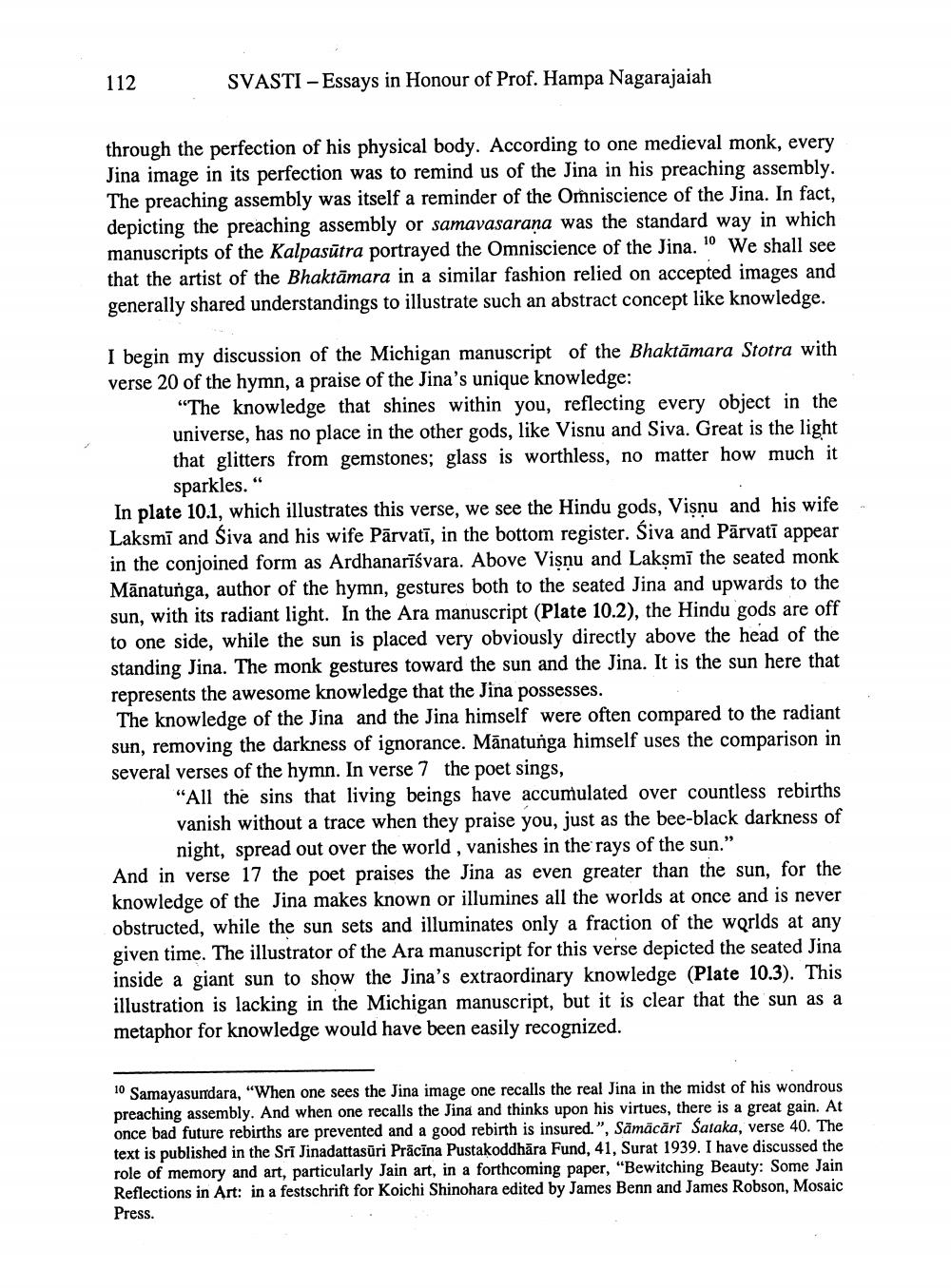________________
112
SVASTI - Essays in Honour of Prof. Hampa Nagarajaiah
through the perfection of his physical body. According to one medieval monk, every Jina image in its perfection was to remind us of the Jina in his preaching assembly. The preaching assembly was itself a reminder of the Omniscience of the Jina. In fact, depicting the preaching assembly or samavasarana was the standard way in which manuscripts of the Kalpasūtra portrayed the Omniscience of the Jina. We shall see that the artist of the Bhaktāmara in a similar fashion relied on accepted images and generally shared understandings to illustrate such an abstract concept like knowledge.
I begin my discussion of the Michigan manuscript of the Bhaktāmara Stotra with verse 20 of the hymn, a praise of the Jina's unique knowledge:
"The knowledge that shines within you, reflecting every object in the universe, has no place in the other gods, like Visnu and Siva. Great is the light that glitters from gemstones; glass is worthless, no matter how much it
sparkles.“ In plate 10.1, which illustrates this verse, we see the Hindu gods, Vişnu and his wife Laksmī and Siva and his wife Pārvatī, in the bottom register. Śiva and Pārvatī appear in the conjoined form as Ardhanarīśvara. Above Visnu and Laksmī the seated monk Mānatunga, author of the hymn, gestures both to the seated Jina and upwards to the sun, with its radiant light. In the Ara manuscript (Plate 10.2), the Hindu gods are off to one side, while the sun is placed very obviously directly above the head of the standing Jina. The monk gestures toward the sun and the Jina. It is the sun here that represents the awesome knowledge that the Jina possesses.
The knowledge of the Jina and the Jina himself were often compared to the radiant sun, removing the darkness of ignorance. Mānatunga himself uses the comparison in several verses of the hymn. In verse 7 the poet sings,
"All the sins that living beings have accumulated over countless rebirths vanish without a trace when they praise you, just as the bee-black darkness of
night, spread out over the world , vanishes in the rays of the sun." And in verse 17 the poet praises the Jina as even greater than the sun, for the knowledge of the Jina makes known or illumines all the worlds at once and is never obstructed, while the sun sets and illuminates only a fraction of the worlds at any given time. The illustrator of the Ara manuscript for this verse depicted the seated Jina inside a giant sun to show the Jina's extraordinary knowledge (Plate 10.3). This illustration is lacking in the Michigan manuscript, but it is clear that the sun as a metaphor for knowledge would have been easily recognized.
10 Samayasundara, "When one sees the Jina image one recalls the real Jina in the midst of his wondrous preaching assembly. And when one recalls the Jina and thinks upon his virtues, there is a great gain. At once bad future rebirths are prevented and a good rebirth is insured.", Sāmācāri Sataka, verse 40. The text is published in the Sri Jinadattasūri Prācīna Pustakoddhāra Fund, 41, Surat 1939. I have discussed the role of memory and art, particularly Jain art, in a forthcoming paper, "Bewitching Beauty: Some Jain Reflections in Art: in a festschrift for Koichi Shinohara edited by James Benn and James Robson, Mosaic Press.




